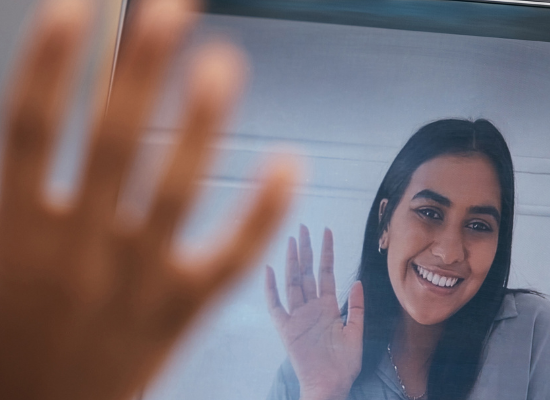
Stephanie Hepburn is a writer in New Orleans. She is the editor in chief of #CrisisTalk. You can reach her at .
After 12 hours in the emergency room and two days into an 11-day inpatient hospitalization, fifteen-year-old Vancouverite Ingrid Parker learned she’d been diagnosed with an eating disorder. Lack of transparency and not being included in dialogue with doctors has been a hallmark of her experience with the healthcare system, which started a year beforehand when she began rapidly losing weight. “I guess because I’m a minor, doctors talked to my parents, not me, but it’s important for me also to be aware of what’s going on, especially when it comes to my own health.”
In May, the Canadian Institute for Health Information reported eating disorder hospitalizations for girls ages 10 to 17 had increased by nearly 60% since the pandemic’s start. The spike illustrates how dire timely access to intervention, prevention, and mental health services are, said Tracy Johnson, director of health system analytics at the nonprofit, noting that the pandemic has put a strain on mental health. Next door, in the United States, the proportion of emergency room visits for eating disorders among adolescent girls doubled in January 2022 compared to January 2019.
As with many teens worldwide, the Covid pandemic disrupted Ingrid’s life—she became disconnected from school, socialization, and dance. “She lost all of the outlets that she excels in and that define her,” says Ingrid’s mother, Monique Helbig. After some semblance of a return to normalcy, the summer of 2021 brought about similar disruption, points out Ingrid—school was out, and dance wasn’t in session. “I wasn’t getting that constant socialization that I like,” she says. As a result, her days lost their typical rhythm. “I was pretty much just laying in bed all day. I’d sleep until two, make some oatmeal, and lounge around.” Although the breaks from school and dance were typical for summer, Ingrid felt them more poignantly after the city’s intermittent Covid lockdowns.
According to a study published in the Journal of Eating Disorders, 40% of participants, adolescents newly diagnosed with an eating disorder between April and October 2020, cited the pandemic as a trigger. “When you’re ripped away from everything you felt so strongly about, and that made you who you are, what are you supposed to do with that?” asks Ingrid. “Where are you supposed to go from there?”
In November 2020, when Vancouver responded to increasing Covid hospitalizations with a social lockdown, Ingrid decided to get a head start on her family’s annual vegan January tradition. In January, her mother joined her in eating vegan, but by February, Helbig noticed her daughter had lost weight. Family and friends who didn’t see Ingrid daily began asking, “What’s happening with Ingrid?”
That’s when Helbig began taking her to experts—a pediatrician, a family doctor, and a naturopath. They monitored Ingrid’s bloodwork, vitals, and weight. “We also got stacks and stacks of books on vegan athletes because Ingrid is a high-performance dancer,” says Helbig.
“I’m not sure how cognizant Ingrid was of what was going on, but none of the experts used the word anorexia.”
Doctors didn’t take Helbig’s concerns about Ingrid’s rapid weight loss seriously until they noticed her low heart rate. “Then they paid attention,” says Helbig. She and Ingrid were at a local lab when the technician told them to remain in the room. “There’s a protocol that if someone’s heart rate is low, they must alert the doctors immediately.” However, a low heart rate isn’t unusual for high-performance athletes, which can dip below 40 beats per minute, so the lab sent mother and daughter home.
Since going vegan, Ingrid noticed her body changing but didn’t realize she had an eating disorder. “I was pretty oblivious.” However, it caught her attention when her mom asked her to wear her watch during a dance conference in November 2021. “It tracked my heart rate, and my mom told me to stop and sit down if it went too high or low,” says Ingrid. “I’ve never had to do that, but I guess she was scared.”
The Monday after the dance conference, the naturopath called Helbig and asked, “Has anyone called you about Ingrid’s bloodwork?” No one had. Ingrid’s labs showed red and white blood cell abnormalities. She had to go to the hospital. “We were in the hospital for days before anyone used the word anorexia,” says Helbig. “I thought she had anorexia but doubted myself since the doctors never validated my concerns—maybe I was wrong, maybe it was cancer.”
Ingrid says inpatient hospitalization was the worst experience of her life. Her movements were limited, and doctors continued to exclude her from conversations about her physical and mental health. “I wasn’t allowed to leave my bed,” she says, “and there was nothing to look at.” “All I could see was the whiteboard that listed my mealtimes.”
They share that navigating the healthcare system has meant experts talking around Ingrid’s eating disorder. Hospital staff on the eating disorder ward and in outpatient programming have focused on Ingrid’s caloric intake, but not on helping her understand what was happening, says Helbig. Ingrid’s healthcare hasn’t been integrative. “They didn’t address the psychological and emotional components of her eating disorder.” In-hospital treatment didn’t include mental health therapy; in fact, Ingrid wouldn’t have access to a therapist until five months after discharge. “In the hospital, a psychiatrist spoke with me briefly just to make sure my diagnosis was correct—that’s it,” notes Ingrid.
Absent throughout has been Ingrid’s voice. She’s left out of the room in conversations, and it’s also felt like they’ve wanted to carve out pieces of her and keep those out of the room as well, says Helbig. Ingrid has also faced chronic mistrust from nurses and doctors. “Suddenly, I’m not trustworthy or believable,” shares Ingrid, “it’s been demoralizing.” She says she understands hospitals and doctors have very strict protocols they need to follow when dealing with eating disorder cases, but it felt like there could have been a better way.
Canada is scaffolding its own 988 mental health and suicide prevention hotline—people will be able to text or call. It’s scheduled to go live in fall 2023. Kids Help Phone, Canada’s leading mental health youth line, will help establish the three-digit number. “To truly be able to do this [988], you have to make sure that every person that dials is going to quickly and seamlessly get connected,” Alisa Simon, executive vice president for Innovation at Kids Help Phone, told CityNews. Before the pandemic, the youth line connected with roughly 1.9 million young people each year. Simon shared that the number has jumped to between 4.5 and 4.9 million annually, with nearly 12 million connections with young people since March 2020.
As national and local leaders build and roll out 988, Ingrid says they must consider how the crisis and healthcare systems work for youth. She points out that a system that isn’t integrative, mistrusts young people, believes them to be incompetent, and locks them out of their own care is fraught with error and is more likely to result in poor outcomes. “I’m going to be independent in a year and a half—shouldn’t the goal be to help me care for myself.”









